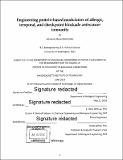| dc.contributor.advisor | K. Dane Wittrup. | en_US |
| dc.contributor.author | Rothschilds, Adrienne Marie. | en_US |
| dc.contributor.other | Massachusetts Institute of Technology. Department of Biological Engineering. | en_US |
| dc.date.accessioned | 2019-11-22T00:09:18Z | |
| dc.date.available | 2019-11-22T00:09:18Z | |
| dc.date.copyright | 2019 | en_US |
| dc.date.issued | 2019 | en_US |
| dc.identifier.uri | https://hdl.handle.net/1721.1/123064 | |
| dc.description | Thesis: Ph. D., Massachusetts Institute of Technology, Department of Biological Engineering, 2019 | en_US |
| dc.description | Cataloged from PDF version of thesis. | en_US |
| dc.description | Includes bibliographical references (pages 128-137). | en_US |
| dc.description.abstract | Effective cancer treatment of the future requires incorporating diverse and innovative aspects of immunity to fight against cancer, accounting for pharmacokinetic and temporal barriers of therapeutics, and engineering approaches to understand and improve upon current immunotherapies. This thesis addresses these challenges in three projects utilizing the Wittrup Lab's quantitative, engineering approach to protein-based cancer immunotherapy. In the first project, I attempted to harness the potency of allergic reactions against cancer by designing IgE class antibodies against two mouse tumor antigens and comparing them with traditional IgG antibodies. These IgE antibodies elicited modest or no tumor control, and limited efficacy could be due to fast pharmacokinetic clearance, absence of human-like allergic effector cells in mice, or tumor-suppressive effects from mast cells responding to IgE. | en_US |
| dc.description.abstract | The second project described in this thesis focused on synchronizing combination immunotherapies with the temporal progression of the anti-cancer immune response. In this work, anti-tumor antibodies were combined with the cytokines interleukin 2 (IL2) and interferon alpha (IFNa). The order of administration of these therapies decoupled strong efficacy from dose-limiting toxicity in two tumor models. Given before IFN[alpha], IL2 activated natural killer cells and heightened their responsiveness to subsequent IFN[alpha], which was ultimately toxic and unnecessary for therapeutic efficacy. This project's proof of concept that efficacy and toxicity could be unlinked in immunotherapy began to establish a framework to use for rational combination therapy treatment schedule design, with the goal of treating with each agent when that piece of the immune system is active. | en_US |
| dc.description.abstract | Finally, the third project used the Wittrup Lab's system of yeast surface display to engineer novel antibodies against the checkpoint blockade target cytotoxic T lymphocyte associated protein 4 (CTLA-4) as tools to improve understanding of the anti-CTLA-4 mechanism of action against cancer. Although the first wave of antibodies made had favorable characteristics against CTLA-4 as a soluble target, they bound a CTLA-4 epitope too close to the cell surface and so could not be used for therapeutic studies. Next generation sequencing on the yeast libraries identified alternative CTLA-4 binding antibody sequences, and these will be tested in future mechanistic and therapeutic studies. | en_US |
| dc.description.statementofresponsibility | by Adrienne Marie Rothschilds. | en_US |
| dc.format.extent | 137 pages | en_US |
| dc.language.iso | eng | en_US |
| dc.publisher | Massachusetts Institute of Technology | en_US |
| dc.rights | MIT theses are protected by copyright. They may be viewed, downloaded, or printed from this source but further reproduction or distribution in any format is prohibited without written permission. | en_US |
| dc.rights.uri | http://dspace.mit.edu/handle/1721.1/7582 | en_US |
| dc.subject | Biological Engineering. | en_US |
| dc.title | Engineering protein-based modulators of allergic, temporal, and checkpoint blockade anti-cancer immunity | en_US |
| dc.type | Thesis | en_US |
| dc.description.degree | Ph. D. | en_US |
| dc.contributor.department | Massachusetts Institute of Technology. Department of Biological Engineering | en_US |
| dc.identifier.oclc | 1127291704 | en_US |
| dc.description.collection | Ph.D. Massachusetts Institute of Technology, Department of Biological Engineering | en_US |
| dspace.imported | 2019-11-22T00:09:17Z | en_US |
| mit.thesis.degree | Doctoral | en_US |
| mit.thesis.department | BioEng | en_US |
